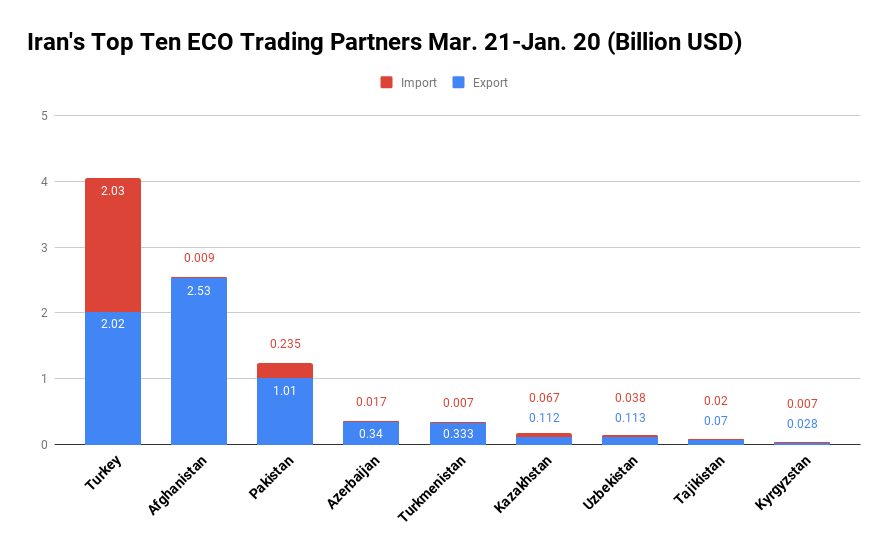Turkey, Afghanistan, Pakistan, Azerbaijan, Turkmenistan, Kazakhstan, Uzbekistan, Tajikistan and Kyrgyzstan are the other ECO countries.
Latest data released by the Islamic Republic of Iran Customs Administration show Iran’s exports totaled 15.39 million tons worth $6.57 billion during the period, indicating a 26.04% and 15.5% increase in tonnage and value respectively YOY.
Imports stood at 1.55 million tons worth $2.44 billion, down 28.58% and 22.94% in tonnage and value respectively YOY, according to Financial Tribune.
An ad hoc organization under the United Nations Charter, Economic Cooperation Organization is a Eurasian political and economic intergovernmental organization founded in 1984 in Tehran by the leaders of Iran, Pakistan and Turkey. It provides a platform to discuss ways to improve development and promote trade and investment opportunities.
Pursuing the establishment of a single market for goods and services, much like the European Union, ECO's secretariat and cultural department are located in Iran, its economic bureau is in Turkey and its scientific bureau is situated in Pakistan.
ECO consists of predominantly Muslim-majority states and is a trade bloc for Central Asian states connected to the Mediterranean through Turkey, to the Persian Gulf via Iran, and to the Arabian Sea via Pakistan.
Main Commodities, Trading Partners
Iran mainly exported liquefied natural gas, low-density oils, bitumen, non-alloy zinc and floorings to ECO member states.
In exchange, major commodities imported into Iran from ECO nations included cooking bananas, semi- and wholly-milled rice, tobacco and cotton.

In terms of trade with Iran, Turkey topped the list among ECO countries with bilateral trade standing at 7.2 million tons worth $4.06 billion, up by 28.91% in tonnage and down by 6.34% in value YOY.
Exports to Turkey amounted to 6.2 million tons worth $2.02 billion to register a 54.58% and 21.33% growth in tonnage and value respectively YOY.
Turkey was Iran’s second biggest export destination among the countries and fifth across the world.
In return, Turkey exported 1 million tons of commodities worth $2.03 billion to Iran, down by 36.33% and 23.65% in tonnage and value respectively YOY.
Turkey was the top exporter of goods to Iran among the ECO states and third in the world after China and the UAE.
Major Iranian commodities exported to Turkey were natural liquefied gas, non-alloy zinc, aluminum and bitumen.
For its part, Turkey mainly exported cooking bananas, tobacco and transmission devices to Iran.
Afghanistan was Iran’s second biggest trading partner among ECO nations during the 10 months, as two-way commercial exchanges stood at 4.83 million tons worth $2.54 billion to register a 0.80% and 11.77% growth in tonnage and value respectively YOY.
Iran exported 4.82 million tons of goods worth $2.53 billion to Afghanistan, up by 1.08% and 12.24% in tonnage and value respectively YOY.
Afghanistan was Iran’s top export destination among ECO states and fourth in the world during the period.
Iran’s exports to Afghanistan included low-density oils, floorings and iron/steel bars.
Iran imported 8,399 tons of commodities worth $9.2 million from Afghanistan, down 61.84% and 47.96% in tonnage and value respectively YOY, a majority of which were sesame seeds, plants used for perfume making and medical purposes, lead, oilseeds and fruits.
Afghanistan was the seventh exporter of goods to Iran among the nations under review and 70th exporter to Iran in the world.
Pakistan was Iran’s third major trading partner among ECO states.
Mutual trade between Iran and Pakistan amounted to 2.4 million tons worth $1.25 billion, indicating an 18.42% and 18.29% increase in tonnage and value respectively YOY.
Iran’s exports reached 2.18 million tons worth $1.01 billion, up 27.45% and 41.24% in tonnage and value respectively YOY, while Pakistan’s exports to Iran were at 218,554 tons worth $235.53 million, down by 30.68% and 30.52% in tonnage and value respectively YOY.
Pakistan was Iran’s third export destination as well as second exporter of goods to Iran among ECO members. The country was Iran’s eighth export destination and 23rd exporter to Iran in the world.
Bitumen, low-density oils, pod vegetables, liquefied hydrocarbon gas and pistachios were Iran’s main goods exported to Pakistan, while Pakistan exported mainly semi- and wholly-milled rice, sesame seeds, pears, mangos and cans.
Kazakhstan was the third biggest exporter to Iran, after Turkey and Pakistan, among ECO countries and 37th in the world, as Iran imported 222,407 tons worth $67.11 million from Kazakhstan during the 10-month period, up by 55.02% and 53.58% in tonnage and value respectively YOY.
Iran mainly imported barley, rapeseed and sheep carcasses and meat from Kazakhstan.
Highest Growths, Declines in Trade
Trade with Azerbaijan (at $357.65 million), Pakistan (at $1.25 billion) and Uzbekistan (at $151.4 million) saw the highest YOY growths of 33.39%, 18.29% and 12.56% respectively, while trade with Tajikistan (at $91.51 million), Turkmenistan (at $341.97 million), and Turkey (at $4.06 billion) witnessed the lowest declines of 55.71%, 7.09% and 6.34% respectively.
Iran’s exports to Pakistan (at $2.18 billion), Uzbekistan (at $113.19 million) and Azerbaijan (at $340.36 million) saw the highest growths of 41.24%, 40.64% and 36.63% respectively, while exports to Tajikistan (at $70.57), Kazakhstan (at $112.37 million) and Kyrgyzstan (at $28.05 million) witnessed the highest declines of 63.79%, 14.58% and 10.61% respectively.
Imports from Tajikistan (at $20.94 million), Kyrgyzstan (at $7.24 million) and Kazakhstan (at $67.11 million) saw the highest growths of 78.36%, 58.96% and 53.58% respectively, while imports from Afghanistan (at $9.2 million), Pakistan (at $235.53 million) and Uzbekistan (at $38.21 million) witnessed the highest decline of 47.96%, 30.52% and 29.26% respectively.


